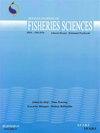Research Article: Population genetics of Penaeus semisulcatus from Persian Gulf and Oman Sea using newly developed DNA microsatellite markers
IF 0.6
4区 农林科学
Q3 FISHERIES
引用次数: 2
Abstract
A population genetics study on Penaeus semisulcatus from Persian Gulf was performed to assist in the selection of suitable broodstocks for future breeding programs. Eight novel microsatellite loci were developed to study population genetics structure of P. semisulcatus in three population sites, Persian Gulf and Oman Sea (Jask, Hormoz and Kuhestak). There were incidences of heterozygosity deficiency and significant deviations from Hardy Weinberg equilibrium (HWE) at most loci (p<0.001). However, four loci (loci E2 and B9 – Hormoz; loci C6 – Kuhestak; and loci H9 – Jask) found to be in HWE. Micro-Checker analysis revealed null alleles in the three microsatellite loci (B5, C6 and C9). Pairwise Fst comparison based on allelic and genotypic frequencies indicated that the three populations were significantly differentiated from each other (p<0.05). High levels of pairwise Fst (0.106) and low levels of Nm (2.103) observed between Hormoz and Jask populations indicated restricted gene flow between the two populations. On the other hand, low levels of pairwise Fst (0.016) and high levels of Nm (15.876) observed between Hormoz and Kuhestak populations indicated high gene flow between these populations. In this study, the assignment test was examined in order to find gene flow connectivity between the three populations. Overall, results revealed high gene flow between Hormoz and Kuhestak and restricted genetic flow between Jask and both Hormoz and Kuhestak populations, providing new input for selection of genetically-suitable broodstocks.研究文章:利用新开发的DNA微卫星标记对波斯湾和阿曼海半角对虾进行群体遗传
对波斯湾半角对虾(Penaeus semiulcatus)进行了种群遗传学研究,为今后的育种计划选择合适的亲本提供了依据。在波斯湾和阿曼海3个种群点(贾斯克、霍尔木兹和库赫斯塔克)建立了8个新的微卫星位点,研究了半骨骨拟南蝽的群体遗传结构。在大多数位点存在杂合性缺陷和显著偏离Hardy Weinberg平衡(HWE)的发生率(p<0.001)。然而,4个基因座(E2和B9 - Hormoz;基因座C6 - Kuhestak;和基因座H9 - Jask)在HWE中发现。Micro-Checker分析显示3个微卫星位点(B5、C6和C9)存在零等位基因。等位基因频率和基因型频率两两比较表明,3个群体间差异显著(p<0.05)。高Fst(0.106)和低Nm(2.103)表明两个群体之间的基因流动受限。另一方面,Hormoz和Kuhestak群体间Fst(0.016)和Nm(15.876)的配对较低,表明两个群体间存在较高的基因流动。在本研究中,为了找到三个群体之间的基因流连通性,进行了分配检验。结果表明,霍尔木兹种群与库赫斯塔克种群之间存在较高的遗传流,而贾斯克种群与霍尔木兹种群和库赫斯塔克种群之间存在较低的遗传流,为选择遗传适宜的亲种鱼提供了新的输入。
本文章由计算机程序翻译,如有差异,请以英文原文为准。
求助全文
约1分钟内获得全文
求助全文
来源期刊

Iranian Journal of Fisheries Sciences
FISHERIES-
CiteScore
2.30
自引率
11.10%
发文量
0
审稿时长
3 months
期刊介绍:
1- Living various species (contains animals and vegetal species) in various aquatic ecosystems.
2- Health and diseases of aquatic species.
3- Determining the stocks and specific time and location for catching and reliable exploitation for sustainable development.
4- Methods of propagation and culture of high value aquatic resources.
5- Aquatic stock assessment and the methods of restocking the high value species and suggestion for rate, areas and the time for releasing fish and other aquatic organisms fries.
6- Pollutant agents and their effects to the environments of aquatic species.
7- Feed and feeding in aquatic organisms.
8- Fish processing and producing new products.
9- The economic and social aspects of fisheries.
 求助内容:
求助内容: 应助结果提醒方式:
应助结果提醒方式:


